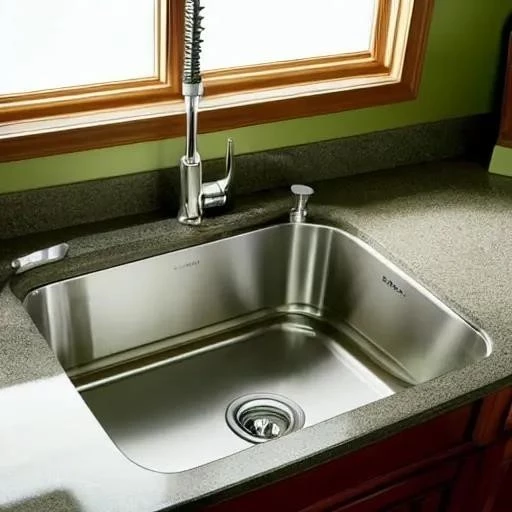In the grand symphony of home design, the kitchen often takes center stage, a vibrant nexus of culinary creation and cherished family moments․ Every element, from the gleaming countertops to the meticulously chosen fixtures, contributes to its overall harmony and enduring functionality․ Yet, amidst the dazzling array of choices and the excitement of a fresh renovation, a seemingly minor detail frequently goes unnoticed, one that holds the key to the long-term integrity and stability of one of your kitchen’s most hardworking components: the overmount sink․
The question “Do overmount kitchen sinks need clips?” might appear trivial at first glance, but its answer profoundly impacts your kitchen’s future, influencing everything from water damage prevention to the very longevity of your investment․ Indeed, overlooking these seemingly minor components can transform a gleaming new installation into a wobbly, water-prone nightmare, potentially compromising the integrity of your costly countertops and cabinetry over time․ These small, often unseen fasteners are, in essence, the silent guardians of your sink’s stability, working tirelessly to secure it firmly in place, defying the relentless forces of daily use․
| Component | Function/Description | Importance | Installation Best Practice |
|---|---|---|---|
| Overmount Sink Clips | Small metal fasteners that attach the sink flange to the underside of the countertop, creating a secure, downward pulling tension․ | Crucial for preventing sink movement, maintaining a watertight seal, and supporting the sink’s weight and contents over time․ | Install evenly around the sink’s perimeter, tightening until snug but not overtightened to avoid cracking the countertop․ Follow manufacturer’s recommendations․ |
| Plumber’s Putty or Silicone Sealant | A pliable, waterproof compound or adhesive used to create a watertight seal between the sink rim and the countertop surface․ | Absolutely vital for preventing water from seeping under the sink rim, which can lead to mold, mildew, and countertop/cabinet damage․ | Apply a generous bead to the underside of the sink rim before setting․ Wipe away excess immediately after securing the sink․ |
| Countertop Material | The surface material into which the sink is installed (e․g․, laminate, solid surface, granite, quartz)․ | Affects the type of clips and sealant used, as well as the overall stability and longevity of the installation․ | Ensure the cutout is precisely sized and sealed properly to prevent moisture absorption, especially with wood-based countertops․ |
| Drain & Faucet Connections | The plumbing components connecting the sink to the water supply and drainage system․ | Properly sealed and tightened connections prevent leaks and ensure efficient water flow, complementing the sink’s secure fit․ | Use thread seal tape (Teflon tape) and pipe dope for watertight seals․ Test all connections thoroughly after installation․ |
| Reference: For detailed installation guides and product specifications, always consult the sink manufacturer’s instructions and reputable plumbing resources like The Home Depot’s Kitchen Sink Installation Guide․ | |||
Imagine a sturdy bridge, designed to withstand the relentless march of time and traffic․ Would its architects ever consider omitting the foundational bolts and anchors, simply trusting gravity to hold it together? Of course not․ Similarly, overmount sink clips serve as these critical anchors, drawing the sink’s rim tightly against the countertop․ This creates not just a physical bond, but a crucial barrier against the insidious threat of water infiltration․ Without them, the sink is prone to shifting, rattling, and, most critically, allowing water to seep into the cabinet below, leading to costly damage, unsightly mold, and compromised structural integrity over time․ The wisdom of opting for clips, therefore, transcends mere preference; it becomes an essential act of preventative maintenance, safeguarding your entire kitchen ecosystem․
Industry professionals consistently advocate for their use, emphasizing that a secure installation is paramount for both aesthetics and longevity․ “A sink that’s not properly clipped,” explains a leading kitchen design consultant, “is a leak waiting to happen․ It’s like building a house on sand – it might look fine initially, but the foundation is inherently unstable․” These clips, often made of durable steel or corrosion-resistant alloys, are meticulously engineered to provide consistent, outward-pulling tension, effectively clamping the sink flange to the underside of the countertop․ Different designs exist, from simple screw-in brackets to more elaborate cam-locking mechanisms, each strategically designed to accommodate various countertop thicknesses and sink materials․ By integrating insights from material science and decades of installation experience, manufacturers have refined these components into incredibly effective tools for ensuring steadfast performance․
Looking ahead, as kitchens evolve with integrated smart technologies and increasingly sophisticated designs, the demand for robust, reliable foundational elements only intensifies․ A well-installed overmount sink, firmly anchored by its clips, contributes significantly to the overall perceived quality and resilience of your kitchen space․ It’s a testament to thoughtful planning and a commitment to durability that resonates with homeowners and future buyers alike․ Embracing these crucial installation practices isn’t just about avoiding problems; it’s about investing in peace of mind, enhancing daily functionality, and ensuring that your kitchen remains a source of joy and efficiency for many years to come․
Ultimately, the answer to whether overmount kitchen sinks need clips is a resounding and unequivocal yes․ They are the unsung heroes, the vital links that transform a beautiful fixture into a resilient, long-lasting component of your home․ By understanding their critical role and ensuring their proper installation, you are not merely securing a sink; you are fortifying the heart of your home against the challenges of everyday life, ensuring that your culinary haven remains both beautiful and incredibly functional, a true testament to intelligent design and lasting quality․






